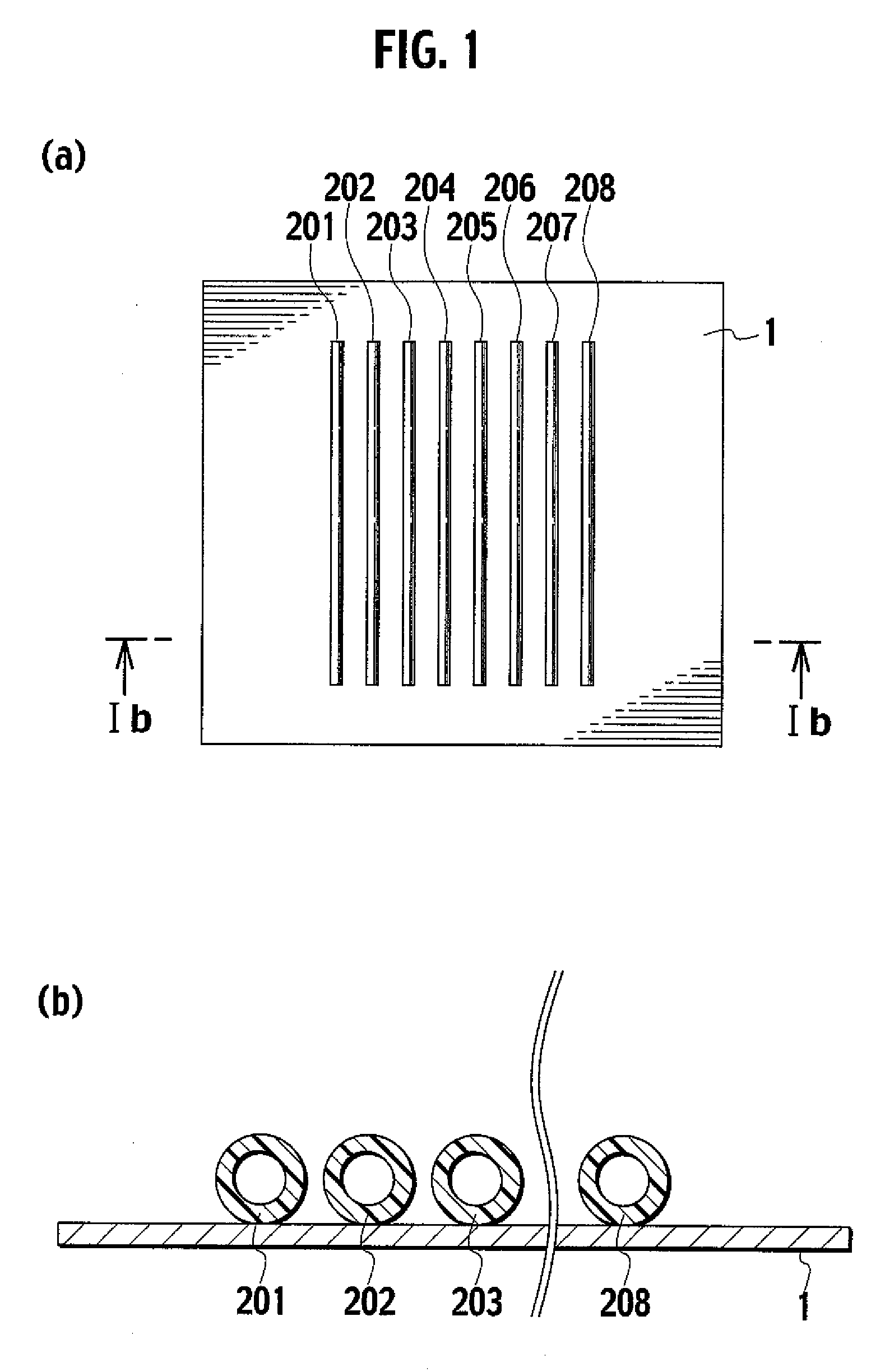Microfluid-System-Supporting Unit And Production Method Thereof
a microfluid-system support and microfluid-system technology, which is applied in the direction of fluid speed measurement, precision positioning equipment, optical light guides, etc., can solve the problems of generating surface irregularities of the microfluid-system support unit, and reducing the flow rate of fluid
- Summary
- Abstract
- Description
- Claims
- Application Information
AI Technical Summary
Benefits of technology
Problems solved by technology
Method used
Image
Examples
example 1
[0208]A double-faced adhesive tape 9415PC (trade name, manufactured by Sumitomo 3M) having a thickness of 0.25 mm was bonded onto one face of a PET film (substrate) having a thickness of 0.05 mm previously cut into a piece of approximately 150 mm in length and 200 mm in width as the intermediate layer having an adhering potential in a roll laminator. A special double tube manufactured by Nitta Moore Company (internal layer: ETFE, external layer: PA11, internal diameter: 1.00 mm, external diameter: 1.50 mm) was made available, and the hollow filament above was placed and fixed on the adhesive layer surface of the double-faced tape in a matrix shape at intervals of 20 mm in the length and width directions. Then, all terminals of the hollow filament in the area approximately 100 mm from the substrate terminal were exposed as the extra-length region. A double-faced tape was bonded at four corners on the other face of the substrate PET film and also into a plastic tray (internal dimensio...
example 2
[0210]An untacky adhesive S9009 (trade name, manufactured by Dow Corning Asia) was applied to a thickness of 0.40 mm at room temperature (25° C.) onto one face of a substrate polyphenylene sulfide (PPS) film (Lumirror, registered trade name, manufactured by Toray Industries, Inc.) having a thickness of 0.06 mm, and the resulting film was cut into a piece of approximately 200 mm in length and 200 mm in width. Then, a PFA-fluorine-resin hollow filament (internal diameter: 0.79 mm, external diameter; 1.53 mm, manufactured by Iwase Co., Ltd.) was made available. The hollow filament of 1 m in length was placed and fixed on the untacky adhesive side of the substrate in a network shape formed by single continuous stroke in an NC wiring machine allowing application of load and ultrasonic wave, and the terminals thereof were exposed out of the substrate as the extra-length regions.
[0211]A polyurethane sealing tape (thickness: 10 mm, width: 15 mm, with adhesive, manufactured by Nitoms Inc.) w...
example 3
[0214]A double-faced adhesive tape (9415PC, trade name, manufactured by Sumitomo 3M) was cut into a piece of approximately 100 mm in length and 200 mm in width, and bonded onto an epoxy resin plate of 110 mm in length, 210 mm in width and 5 mm in thickness with the releasing film facing the epoxy resin plate, and the four corners thereof were fixed with a paper tape. Then, a polyether-imide hollow filament (internal diameter: 0.3 mm, external diameter: 0.5 mm, manufactured by Nirei Industry Co., Ltd.) was made available, and first hollow filaments were placed on the adhesive layer of the double-faced tape in a semicircular pattern at a curvature radius of approximately 20 mm in such a manner that the hollow filaments have a crossing region, in an NC wiring machine allowing application of load and ultrasonic wave. A sponge having a width of 10 mm and a height of 10 mm was made available and bonded to the double-faced tape as the bank in such a manner that it surrounds the hollow fila...
PUM
| Property | Measurement | Unit |
|---|---|---|
| Fraction | aaaaa | aaaaa |
| Fraction | aaaaa | aaaaa |
| Fraction | aaaaa | aaaaa |
Abstract
Description
Claims
Application Information
 Login to View More
Login to View More - R&D
- Intellectual Property
- Life Sciences
- Materials
- Tech Scout
- Unparalleled Data Quality
- Higher Quality Content
- 60% Fewer Hallucinations
Browse by: Latest US Patents, China's latest patents, Technical Efficacy Thesaurus, Application Domain, Technology Topic, Popular Technical Reports.
© 2025 PatSnap. All rights reserved.Legal|Privacy policy|Modern Slavery Act Transparency Statement|Sitemap|About US| Contact US: help@patsnap.com



